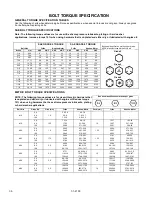
51-4180
22
OPERATION
OPERATING TIPS
Vary brush, engine and travel speeds to match sweeping conditions.
LARGE AREAS
When sweeping a large area, such as a parking lot, make a path down the middle and sweep
to both sides. This reduces the amount of debris that the sweeper must sweep to one side.
SNOW
Fast brush speeds and slow travel speeds are needed to sweep snow effectively. Start at 3/4
throttle and the lowest gear of the prime mover. For wet and/or deep snow, increase to almost
full throttle. This helps keep snow from packing up inside the brush hood.
NOTICE: For best sweeping results, we recommend that the swing assembly be 21”
(533mm) above the ground. Failure to maintain this distance allows for swept material to
be carried over the brush and back onto the swept area.
In deep snow you may need to make multiple passes to get down to a clean surface.
Always sweep with the wind at your back.
DIRT & GRAVEL
To keep dust at a minimum, use the optional dust suppression kit or plan sweeping for days
when it is overcast and humid or after it has rained.
Low brush speeds and moderate travel speeds work best for cleaning debris from hard
surfaces. Brush speeds that are too fast tend to raise dust.
To sweep gravel, use just enough brush speed to “roll” the gravel, not throw it.
HEAVY DEBRIS
For 2” (51mm) or more of heavy debris, a maximum brush speed in the low range and ground
speeds of less than 5 mph (8 kph) are recommended.
THATCH
Low brush speeds and low prime mover speeds do the best thatching job.
To prevent the brush from pulling itself into the ground, adjust the spring-chain assembly so the
bristle tips barely touch the grass.
If the brush pulls into the grass and stalls while sweeping, use the lift to raise the brush.
Do not
increase throttle to override a stall out.
Use a combination of brush speeds and ground speeds that rolls up a neat windrow.
To keep thatch from blowing back into a swept area, sweep with the wind at your back or in the
direction the brush is angled.






























